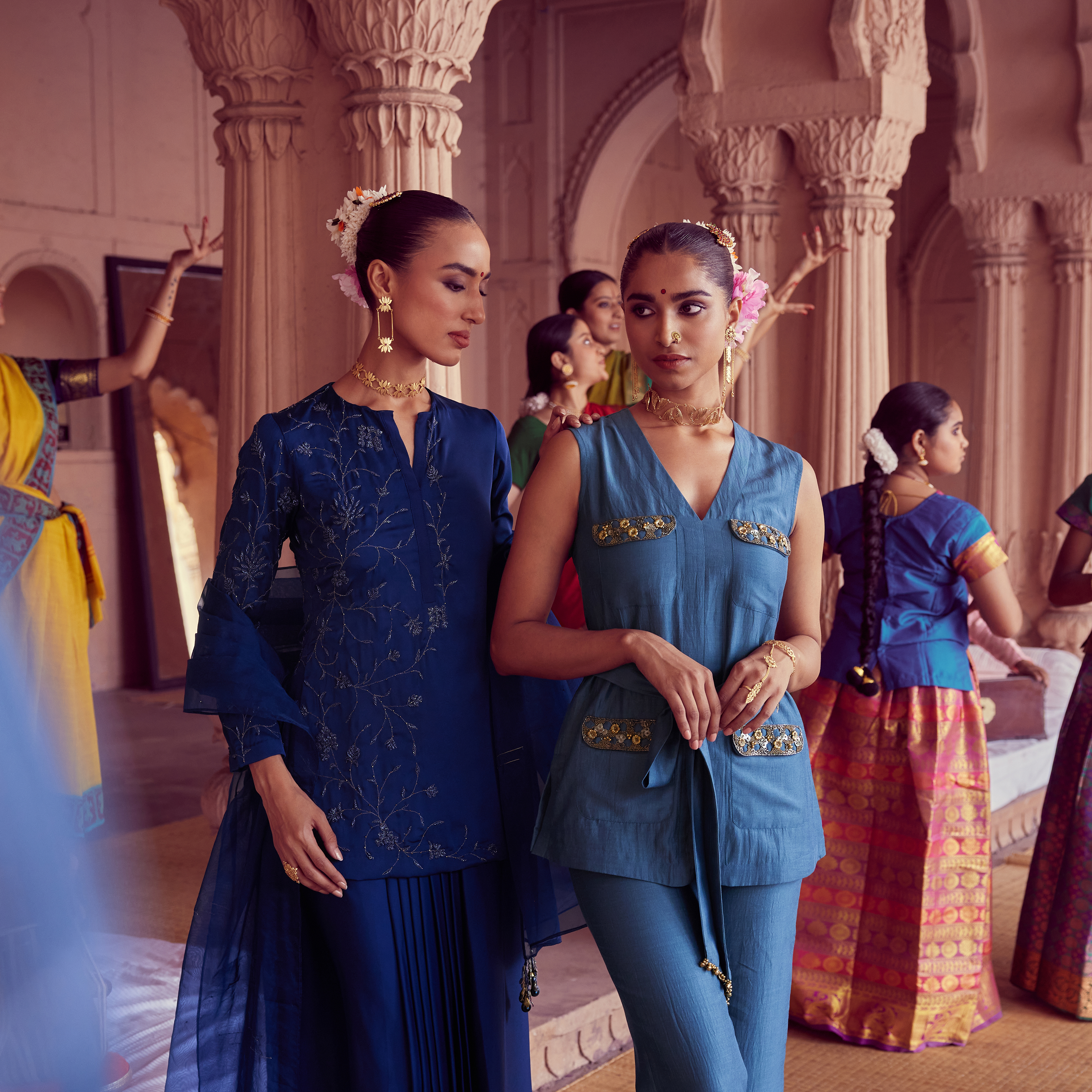Introduction:
Indian dance, with its myriad forms and expressive movements, has long been intertwined with the fabric of Indian culture. Just as dance is a celebration of life, so too is Indian clothing. In this exploration, we delve into the captivating world where the essence of Indian dance converges with the artistry of clothing, creating a mesmerising tapestry of tradition, symbolism, and expression.
1. A Journey Through Dance Forms:
- India boasts a diverse array of dance forms, each with its unique style, rhythm, and symbolism.
- Classical dances like Bharatanatyam, Kathak, Odissi, Kuchipudi, and Manipuri are steeped in centuries-old traditions.
- Folk dances such as Garba, Bhangra, and Lavani celebrate regional cultures and rituals, reflecting the vibrancy of India's diverse landscape.
2. Embodied Expression:
- Indian dance is not merely about movement but also about storytelling, emotion, and spirituality.
- The intricate gestures (mudras) and facial expressions (abhinaya) convey a myriad of emotions, from love and devotion to joy and sorrow.
- Costumes play a pivotal role in enhancing the visual narrative of dance, accentuating the movements and adding layers of symbolism.
3. The Language of Attire:
- Traditional Indian dance costumes are a symphony of colors, fabrics, and embellishments, meticulously crafted to evoke the essence of the dance form.
- Bharatanatyam costumes feature vibrant silk sarees with intricate jewelry, reflecting the grace and poise of this ancient dance form.
- Kathak costumes, characterized by flowing lehengas and dupattas adorned with sequins and embroidery, capture the elegance and fluidity of movement.
- Odissi attire, with its distinctive temple-inspired motifs and rich silk fabrics, embodies the divine beauty and spirituality of this classical dance.
4. Symbolism and Significance:
- Every element of Indian dance attire carries symbolic meaning, reflecting the cultural and spiritual ethos of the dance form.
- The Ghungroo (ankle bells) worn by Kathak dancers symbolize rhythm and melody, accentuating the percussive footwork and enhancing the auditory experience.
- The Maang Tikka (forehead ornament) worn by Bharatanatyam dancers represents the third eye of wisdom, invoking divine blessings and spiritual insight.
- The vibrant colors of folk dance costumes symbolize the festive spirit and cultural identity of the communities they represent, fostering a sense of unity and belonging.
5. Fusion of Tradition and Innovation:
- While traditional attire holds a special place in Indian dance, contemporary interpretations and fusion styles are also emerging, blending tradition with modern aesthetics.
- Contemporary choreographers and designers are experimenting with unconventional fabrics, cuts, and motifs, infusing new life into age-old dance forms.
- Collaborations between dancers, designers, and artisans are fostering innovation and creativity, redefining the boundaries of Indian dance attire in the global arena.
6. Beyond the Stage:
- Indian dance attire transcends the boundaries of the stage, influencing fashion trends, and inspiring designers worldwide.
- Bollywood movies, music videos, and fashion shows often feature iconic dance costumes, showcasing the allure and glamour of Indian dance on a global platform.
- The popularity of Indian dance-inspired clothing, accessories, and jewelry continues to soar, reflecting the universal appeal and enduring legacy of this ancient art form.
Conclusion:
The essence of Indian dance in clothing is a testament to the rich tapestry of culture, tradition, and creativity that defines India's artistic heritage. From the intricate costumes of classical dancers to the vibrant attire of folk performers, each garment tells a story, weaving together the threads of history, spirituality, and expression. As Indian dance continues to evolve and inspire, so too will the timeless allure of its enchanting attire, captivating hearts and minds around the world.
Indian dance, with its myriad forms and expressive movements, has long been intertwined with the fabric of Indian culture. Just as dance is a celebration of life, so too is Indian clothing. In this exploration, we delve into the captivating world where the essence of Indian dance converges with the artistry of clothing, creating a mesmerising tapestry of tradition, symbolism, and expression.
1. A Journey Through Dance Forms:
- India boasts a diverse array of dance forms, each with its unique style, rhythm, and symbolism.
- Classical dances like Bharatanatyam, Kathak, Odissi, Kuchipudi, and Manipuri are steeped in centuries-old traditions.
- Folk dances such as Garba, Bhangra, and Lavani celebrate regional cultures and rituals, reflecting the vibrancy of India's diverse landscape.
2. Embodied Expression:
- Indian dance is not merely about movement but also about storytelling, emotion, and spirituality.
- The intricate gestures (mudras) and facial expressions (abhinaya) convey a myriad of emotions, from love and devotion to joy and sorrow.
- Costumes play a pivotal role in enhancing the visual narrative of dance, accentuating the movements and adding layers of symbolism.
3. The Language of Attire:
- Traditional Indian dance costumes are a symphony of colors, fabrics, and embellishments, meticulously crafted to evoke the essence of the dance form.
- Bharatanatyam costumes feature vibrant silk sarees with intricate jewelry, reflecting the grace and poise of this ancient dance form.
- Kathak costumes, characterized by flowing lehengas and dupattas adorned with sequins and embroidery, capture the elegance and fluidity of movement.
- Odissi attire, with its distinctive temple-inspired motifs and rich silk fabrics, embodies the divine beauty and spirituality of this classical dance.
4. Symbolism and Significance:
- Every element of Indian dance attire carries symbolic meaning, reflecting the cultural and spiritual ethos of the dance form.
- The Ghungroo (ankle bells) worn by Kathak dancers symbolize rhythm and melody, accentuating the percussive footwork and enhancing the auditory experience.
- The Maang Tikka (forehead ornament) worn by Bharatanatyam dancers represents the third eye of wisdom, invoking divine blessings and spiritual insight.
- The vibrant colors of folk dance costumes symbolize the festive spirit and cultural identity of the communities they represent, fostering a sense of unity and belonging.
5. Fusion of Tradition and Innovation:
- While traditional attire holds a special place in Indian dance, contemporary interpretations and fusion styles are also emerging, blending tradition with modern aesthetics.
- Contemporary choreographers and designers are experimenting with unconventional fabrics, cuts, and motifs, infusing new life into age-old dance forms.
- Collaborations between dancers, designers, and artisans are fostering innovation and creativity, redefining the boundaries of Indian dance attire in the global arena.
6. Beyond the Stage:
- Indian dance attire transcends the boundaries of the stage, influencing fashion trends, and inspiring designers worldwide.
- Bollywood movies, music videos, and fashion shows often feature iconic dance costumes, showcasing the allure and glamour of Indian dance on a global platform.
- The popularity of Indian dance-inspired clothing, accessories, and jewelry continues to soar, reflecting the universal appeal and enduring legacy of this ancient art form.
Conclusion:
The essence of Indian dance in clothing is a testament to the rich tapestry of culture, tradition, and creativity that defines India's artistic heritage. From the intricate costumes of classical dancers to the vibrant attire of folk performers, each garment tells a story, weaving together the threads of history, spirituality, and expression. As Indian dance continues to evolve and inspire, so too will the timeless allure of its enchanting attire, captivating hearts and minds around the world.








Leave a comment
This site is protected by hCaptcha and the hCaptcha Privacy Policy and Terms of Service apply.